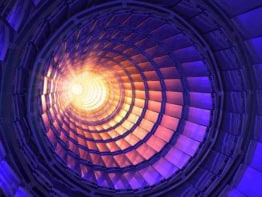
The cause of the huge magnet warm-up or “quench” at the Large Hadron Collider (LHC) a month ago that released masses of helium coolant into its tunnel was a faulty electrical connection, an official report has confirmed.
The report, which was completed by the CERN lab near Geneva on Wednesday and released publicly yesterday evening, reveals that the fault resulted in the loss of some six tonnes of liquid helium, broken anchors in the concrete floor and damaged “jumper” connections in the cryogenic distribution line. It also states that up to 29 magnets will have to be repaired.
But the report adds that there are enough spare components to allow the LHC to restart in 2009 at the full energy of 7 TeV after the accelerator’s standard winter maintenance period.
Robert Aymar, the director-general of CERN, said in a statement, “The incident was unforeseen, but I am now confident that we can make the necessary repairs, ensure that a similar incident cannot happen in the future and move forward to achieving our research objectives.”
We are taking this process slowly and carefully to ensure that we do not miss anything that could help in the final analysis Paul Collier, CERN
Resistive zone
The report describes in detail the sequence of events that lead to the 19 September quench, which was first revealed by physicsworld.com. It began soon after 11 a.m. CET (10 a.m. BST) when the operations team was commissioning the final eighth of the LHC, sector 3–4, to an energy of 5.5 TeV. To do this, the team had to ramp up the current in the circuits of the “dipole” magnets, which steer the machine’s proton beams. Unfortunately — and for reasons yet unknown — the higher current was met by resistance in an electrical link between a dipole magnet and a neighbouring “quadrupole”, or focusing, magnet.
This resistance put an unwanted load on the power supply. In response, the power supply switched off and triggered a batch of resistors in the circuit to curb the high current. It also triggered quenches in many nearby magnets — an automatic safety system that is in place to distribute excess energy over a wide area.
Meanwhile, an electrical arc sprung from the fault and punctured a hole in the magnets’ cooling enclosure, allowing liquid helium to escape into the outer, thermally insulating vacuum of the cryostat. Relief valves in the cryostat opened to let out the helium into the tunnel — initially about two tonnes, though over time another four tonnes. However, the pressure of the helium was so great that several cryostats shifted and broke their anchors in the concrete floor. It was this movement that was responsible for the damaged the cryogenic jumper connections, which exist every 107 m along the sector.
‘Safe powering in the future’
According to the report, engineers will have to remove at most five quadrupole and 24 dipole magnets for repair. But it adds that the engineers may be forced to lift even more magnets from the 100 m-deep tunnel to the surface for cleaning because of a “soot-like” dust that was sprinkled down the beam pipes.
CERN now plans to improve the pressure release devices and cryostat anchors, and add more measurements to the early-warning systems before the technicians attempt to feed in any more high currents.
The technical parameters of the LHC are beyond precedent, and the energy stored in the superconducting magnets huge Official CERN report
“The technical parameters of the LHC are beyond precedent, and the energy stored in the superconducting magnets huge,” the report concludes. “Consequently, operation of this machine will always comprise a certain technical risk. We are however convinced that the repair actions underway and the improved protection systems to be implemented will ensure safe powering in the future.”
Paul Collier, the head of the accelerator operations team, told physicsworld.com that those at CERN are still in the process of warming up the entire sector, though they have begun inspecting the interconnects between magnets to gather more information. “We are taking this process slowly and carefully to ensure that we do not miss anything that could help in the final analysis,” he says.
“We have not yet fully disconnected any magnets,” he continues. “This will happen in the next week or so. Once disconnected, the first magnets — initially [those in the] short straight sections — will be removed from the machine for further study and the repair process started.”
Aside from the collateral damage it caused, the problem on 19 September was a blow to CERN scientists who had only recently celebrated a highly successful “switch on” and who were just days from being able to collide proton beams at 5 TeV. While further analysis of the incident continues over the winter, the operations team will have to find ways to rekindle its morale.
• You can read the full copy of the CERN report here.



